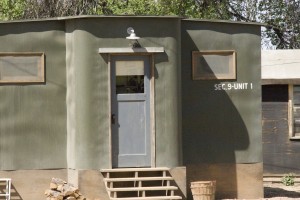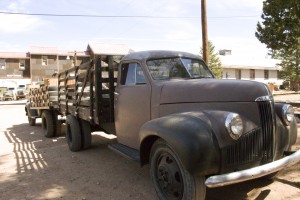Tags
Related Posts
Share This
Manhattan Saves the Barracks

Small quarters were given to the soldiers assigned to the Manhattan Project. Photo by Charlotte Martinez.
In 1943, two years into WWII, Santa Fe built semi-permanent barracks for a military hospital on what is today the Santa Fe University of Art and Design campus. When the war ended, a majority of the haphazard structures were stripped, sold to the De La Salle Christian Brothers, and rebuilt as classrooms for the Saint Michael’s College. Since then, the small box-shaped quarters have been transformed into living spaces, a cafeteria, a chapel and, after the relocation of the Christian Brothers in 2009, reduced to mere molding storage owned by the state.
Now, after 71 years, instead of being bulldozed and forgotten, the barracks have made an unexpected return. The narrow halls and wooden cubicles are again housing a WWII effort (in a manner of speaking). On Jan. 6, the production team of the new TV Series “Manhattan” bought the remaining barracks and its surrounding land from the state of New Mexico and transformed it into the image of Los Alamos’s Manhattan Project site, the area surrounding Ashley Pond where from 1942 until 1945 some 30 scientists constructed the atomic bomb.
Written by Sam Shaw and directed by Thomas Schlamme, “Manhattan” TV Series stars Daniel Stern, John Benjamin Hickey and premieres July 27 on WGN America.
It is a “very dark story, all about secrets and how secrets tear families apart,” says Film School Associate Chair Paula Amanda, who has worked closely with the production since they arrived.
Employing some 3,000 actors and 200 local workers, “Manhattan” tries to remain as historically accurate as possible, mimicking the layout of the original Los Alamos site by constructing lodges, labs, fences, and checkpoints- the same secretive atmosphere surrounding the scientists.
Sam Tischler, “Manhattan” location manager, explains that for a project that plans to shoot several episodes, it’s more efficient to work with owned rather than borrowed property. The opportunity to use Santa Fe’s military barracks, the same construction Los Alamos used for their Manhattan barracks during WWII, was not just convenient but pretty lucky.
Despite having to first “wad[e] through garbage,” paint over vandalism and remove the asbestos from the barracks, Tischler says the 80 or so set dressers had the Manhattan site recreated and ready for first shots by March. The transformed set included period-accurate vehicles, equipment and of course the wooden structures where scientists and their families lived and worked.
In remaining as historically accurate as possible, the production’s layout also mimics a good many sections of the original Manhattan site, including Bathtub Row, Fuller Lodge, Trinity Drive and the overpass connecting the labs. The props are just as accurate. Typewriters, bookcases, chalkboards, a jukebox, a cigarette machine and propaganda emphasizing the 1940s wartime effort. ‘Make this one count, buy more bonds,’ one sign says and ‘Espionage is always a threat, don’t discuss your work off the job’ hung in front of the worker wives at the switchboard.
“It was rough living,” Tischler says, describing the wives who accompanied their husbands to Los Alamos. Being “cut off from the world,” Tischler explains, and kept in the dark about their husband’s work made for high tension, which is a main focus in the series.







 Jackalope Magazine is the student magazine of Santa Fe University of Art and Design. Building on the interdisciplinary nature of our education, we aim to showcase the talent of our university and character of our city.
Jackalope Magazine is the student magazine of Santa Fe University of Art and Design. Building on the interdisciplinary nature of our education, we aim to showcase the talent of our university and character of our city.
Recent Comments